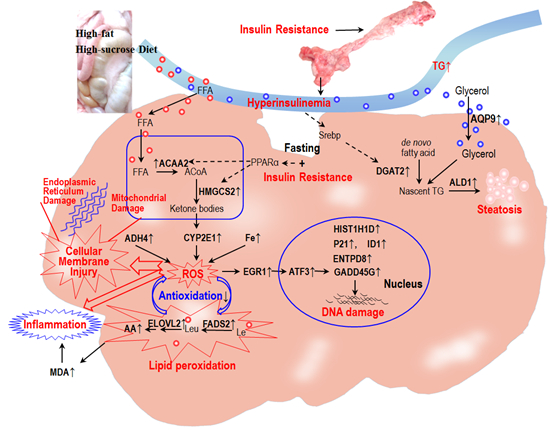分享到
Energy supply shifted from glucose to ketone bodies trigger the NASH in early stage by minipigs model
Nonalcoholic fatty liver disease (NAFLD) is a burgeoning global health problem and includes a disease spectrum ranging from simple steatosis to nonalcoholic steatohepatitis (NASH), liver fibrosis, cirrhosis, and hepatocellular carcinoma. The development and progression of NASH can require decades. Because of ethical constraints on obtaining human liver tissue, the quality and interpretation of longitudinal data from humans are necessarily limited. The pig is an exceptional model of obesity and metabolic syndrome research because the metabolic features, cardiovascular systems, and omnivorous habits are similar to those of humans. Further, the advancement in porcine genomics, proteomics, and genetic modification techniques will facilitate the use of pig models in extensive applications in the biomedical field.

This study examined the development of metabolic syndromes in Bama minipigs fed a high-fat high-sucrose diet (HFHSD) for 23 months using histological, serum and profiling the gene expression patterns of the livers from HFHSD pigs as compared to the controls. Pathology findings revealed microvesicular steatosis, iron overload, arachidonic acid synthesis, lipid peroxidation, reduced antioxidation capacity, increased cellular damage, inflammatory in the liver. RNA-seq analysis revealed that 164 genes were differentially expressed between the livers of the HFHSD and control groups. The pathogenesis characteristic of NASH in early stage exhibited as, hyperinsulinemia promoted the de novo synthesis of fatty acids and nascent triglyceride, which were deposited as lipid droplets in the hepatocytes. Hyperinsulinemia shifted the energy supply from glucose to ketone bodies, and the high ketone body concentration induced overexpression of cytochrome P450 2E1 (CYP2E1). The iron overload and CYP2E1 and alcohol dehydrogenase 4 overexpression mediated reactive oxygen species (ROS) production, which resulted in arachidonic and linoleic acid peroxidation, leading to malondialdehyde production, and a cellular response to ROS-mediated DNA damage.
This study was supported by grants from the National Natural Science Foundation of China (31372276), the State Key Development Program for Basic Research of China (2012CB517501), the National Basic Research Program (2011CBA01005), the National Key Technology Support Program (2012BAI39B04), the Agricultural Science and Technology Innovation Program (ASTIP-IAS05, ASTIP-IAS-TS-4), the Development Program of China (2012AA020603) and The Science and Technology Project of Shenzhen(CXZZ20140504105105077).
This work has been published on Scientific Reports on September 11, 2015. More details are available on the links bellow:
http://www.nature.com/articles/srep13980

This study examined the development of metabolic syndromes in Bama minipigs fed a high-fat high-sucrose diet (HFHSD) for 23 months using histological, serum and profiling the gene expression patterns of the livers from HFHSD pigs as compared to the controls. Pathology findings revealed microvesicular steatosis, iron overload, arachidonic acid synthesis, lipid peroxidation, reduced antioxidation capacity, increased cellular damage, inflammatory in the liver. RNA-seq analysis revealed that 164 genes were differentially expressed between the livers of the HFHSD and control groups. The pathogenesis characteristic of NASH in early stage exhibited as, hyperinsulinemia promoted the de novo synthesis of fatty acids and nascent triglyceride, which were deposited as lipid droplets in the hepatocytes. Hyperinsulinemia shifted the energy supply from glucose to ketone bodies, and the high ketone body concentration induced overexpression of cytochrome P450 2E1 (CYP2E1). The iron overload and CYP2E1 and alcohol dehydrogenase 4 overexpression mediated reactive oxygen species (ROS) production, which resulted in arachidonic and linoleic acid peroxidation, leading to malondialdehyde production, and a cellular response to ROS-mediated DNA damage.
This study was supported by grants from the National Natural Science Foundation of China (31372276), the State Key Development Program for Basic Research of China (2012CB517501), the National Basic Research Program (2011CBA01005), the National Key Technology Support Program (2012BAI39B04), the Agricultural Science and Technology Innovation Program (ASTIP-IAS05, ASTIP-IAS-TS-4), the Development Program of China (2012AA020603) and The Science and Technology Project of Shenzhen(CXZZ20140504105105077).
This work has been published on Scientific Reports on September 11, 2015. More details are available on the links bellow:
http://www.nature.com/articles/srep13980
Latest News
-
 Apr 18, 2024Opening Ceremony of the Training Workshop on Wheat Head Scab Resistance Breeding and Pest Control in Africa Held in CAAS
Apr 18, 2024Opening Ceremony of the Training Workshop on Wheat Head Scab Resistance Breeding and Pest Control in Africa Held in CAAS -
 Apr 03, 2024IPPCAAS Co-organized the Training Workshop on Management and Application of Biopesticides in Nepal
Apr 03, 2024IPPCAAS Co-organized the Training Workshop on Management and Application of Biopesticides in Nepal -
 Mar 28, 2024Delegation from the School of Agriculture and Food Science of University College Dublin, Ireland Visit to IAS, CAAS
Mar 28, 2024Delegation from the School of Agriculture and Food Science of University College Dublin, Ireland Visit to IAS, CAAS -
 Mar 25, 2024Director of World Food Prize Foundation visited GSCAAS
Mar 25, 2024Director of World Food Prize Foundation visited GSCAAS -
 Mar 20, 2024Institute of Crop Sciences (ICS) and Syngenta Group Global Seeds Advance Collaborative Research in the Seed Industry
Mar 20, 2024Institute of Crop Sciences (ICS) and Syngenta Group Global Seeds Advance Collaborative Research in the Seed Industry
